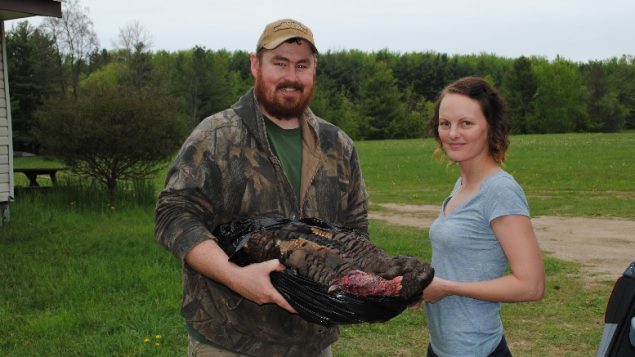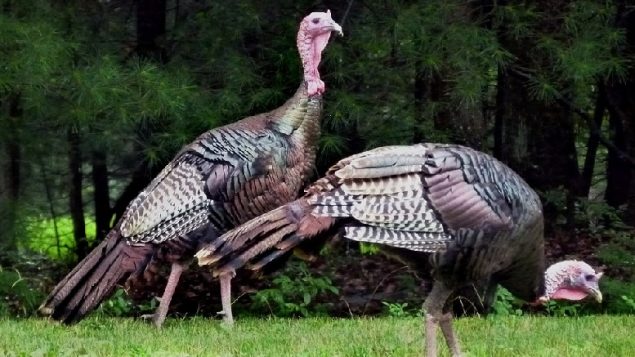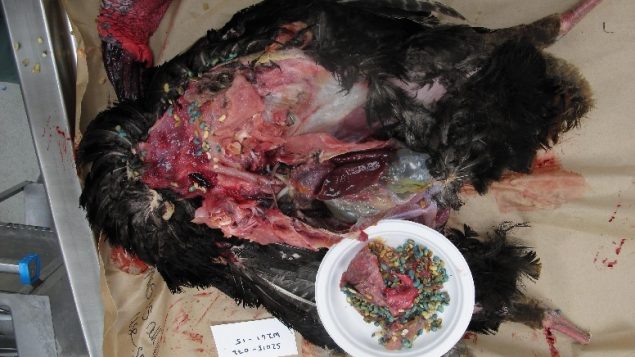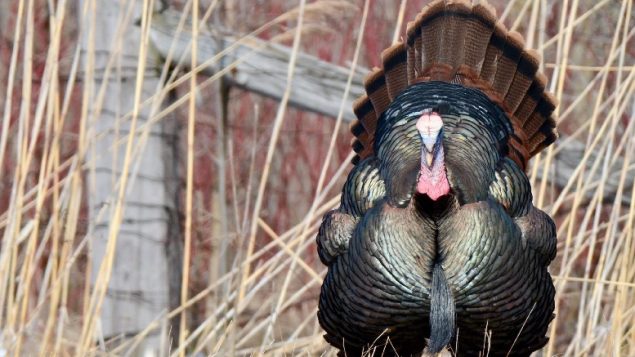Toxic chemical targets insects, but found in birds
Hunters in Ontario suspected something was wrong. In recent years, there seemed to be fewer of the wild turkeys they usually hunt.
They suspected the birds were feeding on crop seeds coated with the insecticide group known as neonicotinoids and they wondered if that it may be affecting the bird’s health and reproduction
With cooperation from the Ontario Federation of Anglers and Hunters, a few dozen samples of hunted wild turkey were sent to the University of Guelph and patho-biologist Amanda MacDonald (PhD),now a Postdoctoral Research Fellow with Environment and Climate Change Canada and the Canadian Wildlife Health Cooperative under the supervision of Dr. Nicole Nemeth.
ListenThe group of insecticides known as neonicotinoids have long been under fire for the suspected harm they cause to pollinators who visit the fields near neonicotinoid crops, and the crops themselves.

Researcher Amanda MacDonald (PhD) at right with Brian Moore chairman of the OFAH Zone J (Emily Levidis-Moore)
In addition to the strong evidence that the chemicals are causing massive bee deaths, studies using samples from around the world have found traces of the neuro-toxin in the honey we consume.

Wild turkeys, like many other birds and even small mammals, will gladly feast on seed in newly sown fields. However, now many crop seeds are now coated with the neuro-toxic insecticides (Pixabay)
The wild turkeys, and several other avian species like partridge, will also move into freshly planted fields and eat freshly planted seeds which are coated with the neonics.
In studying the livers of the turkeys sent in from around southern Ontario, MacDonald’s research team found various levels of neonics present.
The findings were published in the journal “Environmental Science and Pollution Research” under the title “Neonicotinoid detection in wild turkeys (Meleagris gallopavo silvestris) in Ontario, Canada ( open access HERE)

Necropsy of a wild turkey showing a number of neonicotinoid corn seeds found in the bird. (Amanda MacDonald PhD)
While MacDonald will not speculate on the effect of the toxins on a large bird like a wild turkey, the study notes that smaller birds like a blue jay eating just a couple of the toxin-coated seeds, could prove fatal to them.
She notes the study was only able to examine the livers of the turkeys and could not speculate if the toxic chemicals had spread into the meat. However, eating the organs such as liver or heart of hunted turkeys are not uncommon.
The study found that almost half of the turkey livers had detectable levels of the neonics or fungicides or both.
Although found at low-amounts, even if the neonics themselves were not immediately fatal, she noted there is always potential for harm from combinations of chemicals and pollutants and of bio-accumulation over time.
The study also cited other research which indicated that insecticides and fungicides are suspected to play a role in failed partridge eggs and pheasant deaths in France and the U.K.
MacDonald notes the limitations of this particular research effort but adds that it does point out that although these chemicals have a specific target, their non-intended effects can spread far beyond what was originally thought. She hopes others will be concerned and inspired by the team’s findings and pursue further research in this area.







For reasons beyond our control, and for an undetermined period of time, our comment section is now closed. However, our social networks remain open to your contributions.